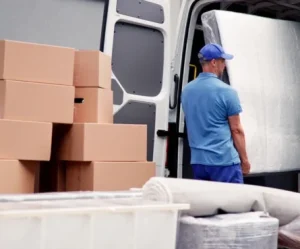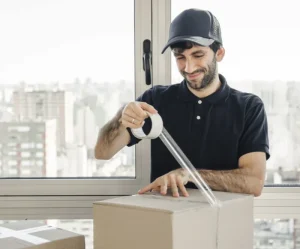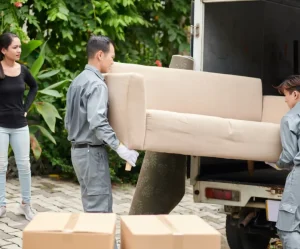How to pack a POD (Portable On-Demand Storage) begins with understanding what a POD is. A POD is a programmable steel container delivered right to your home or business that helps you load within your time constraints. PODs have grown in popularity for both local and long distance moves because of their wallet-friendly convenience, security, and flexibility when preparing for your move.
When packing pods for moving, the organization of your items is paramount. With a well packed POD, you will be able to maximize the storage potential, protect belongings from damage, and provide a more efficient unloading experience. Whether you use the POD for long term short term storage or to move your entire household across town, spending a little time to pack a pod properly will ensure all your items stay safe, secure and organized throughout the process.
Essential Packing Materials for Your Storage Pod

Packing for the move or storage is much simpler when you have the appropriate supplies ready to go. Using the correct packing products, whether you’re packing-up for a move or for storage, will help keep your personal belongings organized and intact; ultimately making it easier to unload. Here are the important supplies to have on hand at packing the pod:
1. Strong Moving Boxes
Use a variety of strong boxes in different sizes:
- Small boxes: Are great for books, tools, and any heavy compact items
- Medium boxes: Used for kitchen decor, electronics, or small electronic appliances
- Large boxes: Used for lightweight space fillers-such as bedding, linens or pillows.
In all occasions, strong moving boxes or boxes pre-constructed for the purpose of moving or storage should always be considered to make sure the boxes will not collapse or tear on you.
2. Bubble Wrap, Packing Paper & Stretch Wrap
You should consider having all of these as protection for your fragile and oddly shaped items:
- Bubble wrap: Great for cushioning glassware, collectibles & valuable items
- Packing paper: Great for keeping dishes, ceramics or fragile items safe.
- Stretch wrap: Great for keeping furniture together and/or bundling items into groups, as well as to protect against scratches.
These materials reduce shifting inside the pod and keep everything stable.
3. Furniture Pads & Moving Blankets
Use furniture pads or blankets between items to prevent dents, scuffs, and scratches. Additionally, packing pads will provide more cushion for your large items while they are in transit or in storage.
4. Heavy-Duty Packing Tape & Dispenser
Use durable packing tape to ensure you tape boxes securely shut. Use a packing tape dispenser to expedite the tape process to ensure every box remains closed during your move.
5. Labels, Markers & an Inventory List
Clearly identify each box with a room name or contents. Keep a list of inventory, which will be easier for you to keep track of your belongings and stay organized while packing a pod.
6. Dollies, Straps & Rope
A dolly will help you transport heavy furniture and boxes with ease. Straps and rope should be used to secure large or oversized items to avoid them moving inside the pod. If you want packing services in Sherman Oaks, contact no other than Chamomile Go.
Tips for How to Pack a POD for Moving
Having a strategy in pods packing can make the entire process safer, faster, and more efficient. Whether you’re using PODS rentals or another type of storage container, the right approach helps protect your belongings while maximizing the space available. Follow these tips to guide you through packing your container the proper way.
1. Consider a Loading Plan
Before you throw belongings in a pod, take a minute to scope out how your load is going to look:
- Make a list of every item to be put into the pod
- Organize belongings by weight, size, and fragile-ness (if they have it)
- Draw a rough picture of what, in order, the loading process will be.
Taking the time to create a plan pays off in time saved and stress by doing everything on the fly.
2. Load Heavy Items First
Begin the packing process with larger to heavy items, such as:
- Dresses, Couches, Mattresses
- Washer, Dryer, Refrigerator
Once you pack those at the bottom and pressed against the back wall of the pod, you are starting to establish a solid foundation.
3. Distribute Weight Evenly
Equally balancing the weight while properly packing pod is important. Make sure to spread the weight across the pod from one end of the pod to the other side or from the front to the back. The value is reducing the ability for something to shift while being transported.
4. Stack the Boxes from Heaviest to Lightest
When packing a pod, the order of the boxes matters:
- Heavier boxes should go on the bottom
- Lighter box should go on top
- Fragile items can be cushioned in the middle.
That way your valuables are protected and the stacks won’t fall over!
5. Use as Much Vertical Space as Possible
Pack everything up to the ceiling of the pod to utilize the vertical space. Pack tall furniture upright; fill in gaps with smaller boxes or bags to keep them from moving.
6. Leave Room Access, if necessary
If you will need access to items before unloading the pod, consider making a narrow aisle or additional boxes marked with something special so you know you will need to access these before it is all unloaded. This may be especially useful if you are storing things for a longer period.
7. Secure with Straps and Ropes
As you load:
- Use straps or ropes to tie down each layer
- Anchor furniture to the container walls
- Tighten straps after every few rows for added security
How to Pack Fragile Items and Valuables in a POD

When loading pods for moving, fragile and valuable items require a more careful process of packing. Using the proper techniques will reinforce that glassware, electronics, and other delicate items travel to your new home without damage.
1. Wrap Each Fragile Item Individually
Wrap each fragile item like glassware and dishes in packing paper, bubble wrap, or foam padding. Secure this wrap with tape, and wrap items such as:
- Glassware and dishes
- Ceramics, collectibles, and décor
- Electronics and small appliances.
2. Use Dividers or Specialty Boxes
If packing dishes, glasses, or stemware, select boxes that have built-in divider inserts or pack leading dishes. The dividers help to keep the items upright and cushioned inside, reducing movement in the container.
3. Add Cushioning Inside Boxes
Each box you use for fragile items should be lined with cushioning pad on all sides. Bubble wrap, foam peanuts, packing paper, or even soft towels, will help absorb the shock as the items are transported.
4. Put Fragile Boxes on Top
Put delicate items facing upwards. You don’t want them to sustain any damage from the weight of other boxes. Be sure to clearly label each box “FRAGILE” and “TOP LOAD ONLY” so everyone will know what to do.
5. Do Not Stack Heavy Boxes On Fragile Boxes
Large or heavy boxes should never be awkwardly stacked on top of your delicate items. Even for a short period of time, the weight could still produce cracks or breaks in your items.
6. Protect Anything of High Value
For things such as jewelry, heirlooms, or any other computer equipment that is expensive, look over your insurance coverage or look into any valuation protection that the container company might offer. If possible, keep these high-value items with you to quench any worries.
The Best Way to Load and Unload a Container
The proper way to handle a container will make the move easier, safer, and more organized. If you follow the proper steps, you can minimize damages to your belongings and minimize stress. Here’s some practical advice for loading and unloading.
Loading Suggestions
1. Put Heaviest Items Towards the Back and Bottom
Begin with your large furniture, appliances, and boxes that will be filled with heavy things. Place these flat on the floor at the back wall to give you a foundation that is both stable and balanced.
2. Pad Furniture
Protect your wood, metal, or upholstered furniture with moving pads or blankets. This will help avoid indentations, scratches, and other damage to your belongings should they shift or rub against each other.
3. Secure Each Section of the Load
As you begin to load each layer, tie down or strap your items down, layer by layer. This keeps everything in place and safe for transport while greatly reducing the risk of your items breaking.
Unloading Advice
1. Open Doors Slowly
The contents could have shifted while transporting. Begin by standing to the side of the door and open very slowly to let any boxes or contents fall out that might fall out before you reach in.
2. Pack Out the Top Down
When unloading a truck, start with lighter boxes and smaller items first. Leave the heavier items for the end to allow for a safe and seamless box unloading. You want to make sure nothing tips over, or gets damaged while moving things around.
3. Use Proper Tools for Moving Larger Items
A dolly or hand truck will make it much easier to move larger furniture and appliances while protecting your back and floors.
4. Check Off Your Items as You unload
Be sure to check off each item that leaves the truck and mark it off your inventory. To make sure nothing gets left behind and to verify everything arrived in one piece.
Final Thoughts
Smart packing starts with planning ahead, using the right materials, and following proven strategies like loading heavy items first and securing everything in place. Proper packing not only protects your belongings but also saves time and stress on moving day. For large, fragile, or valuable items, it’s always best to consult professionals who handle these challenges every day. At Chamomile Go, we specialize in reliable and affordable moving services in Sherman Oaks, helping local residents with everything from packing to loading and transportation. Whether you’re using a POD or moving into a new home, our team is here to make your experience smooth and worry-free. Contact us today for expert help tailored to your needs.
FAQs
Q1: What Is The Best Way To Pack A Pod For Moving?
The best way to pack a pod is to start with a plan. Load heavy items like furniture and appliances at the bottom and toward the back. Use moving supplies such as furniture pads, straps, and sturdy boxes to secure and protect your items inside the storage container.
Q2: Should I Disassemble Furniture Before Packing A Pod?
Yes. Disassembling furniture helps maximize space and prevents damage. Remove legs from tables, detach headboards, and keep hardware in labeled bags. This also makes packing a pod more efficient.
Q3: How Do I Prevent Items From Shifting Inside The Pod?
Use straps, rope, and tie-downs to secure each layer of boxes and furniture. Place heavier items on the bottom and use padding between breakables. Securing everything tightly is essential when you pack a pod for transport.
Q4: Can I Pack Fragile Items In A Pod?
Absolutely. When packing a pod, wrap fragile items individually with bubble wrap or packing paper, use dish boxes with dividers, and clearly label all fragile boxes. Load them on top and avoid placing heavy boxes above them.
Q5: Is It Safe To Store A Packed Pod For A Long Time?
Yes, as long as you pack it properly. Use high-quality moving supplies, protect items from moisture with covers or plastic wrap, and avoid overpacking. PODS rentals are weather-resistant, making them safe for both short- and long-term storage.




